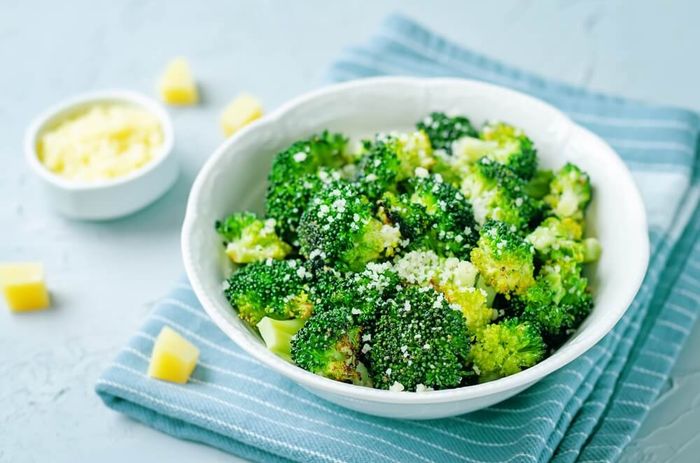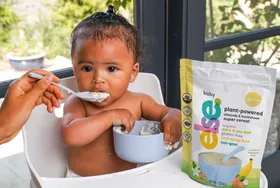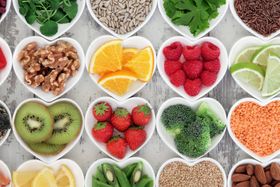High Iron Foods for Kids
Explore delicious and nutritious high iron foods for kids with these iron-rich recipes that are sure to please even the pickiest eaters.
Updated May 23, 2024.

With all of the things constantly on the minds of parents and caregivers, providing their children with good nutrition is often at the forefront. If you’re raising plant-based kids, certain nutrients are particularly important to pay attention to, as they may not be as bioavailable or widely present in whole plant foods. One of these is iron, an important nutrient for growing kids and adults alike. Understanding where iron can be found and how to boost absorption can help you make sure your kids get enough.
» Make sure your little one is getting enough iron with these plant-based cereal
Why is Iron Important for Kids?
Iron is an essential mineral with a number of key roles in the body. It’s a component of hemoglobin, which is a protein in red blood cells that transports oxygen from the lungs to the rest of the body, including tissues. It’s also a component of myoglobin, another protein in the muscles that provides oxygen and supports healthy connective tissues.
Iron is an important nutrient for everyone throughout life, but especially for children who are growing and developing at a fast rate. Getting enough dietary iron is critical for cellular functioning, making certain hormones, brain development, and physical growth.
» Read more about expert nutrition tips for babies, toddlers and kids
What Are Types of Iron in the Diet?
There are two main forms of iron in the diet: heme and nonheme iron.
Heme iron is predominantly found in animal-derived foods, such as meat, poultry, and seafood. Nonheme iron, on the other hand, is found only in whole plant foods as well as foods that have been fortified with iron.
While both forms of iron can effectively meet your child’s iron needs, there are some differences in their bioavailability. Heme iron is generally more easily absorbed by the body than nonheme iron.
» Boost your baby's iron intake with this nutritious cereal
How Much Iron Does My Child Need?
Experts say those who follow a plant-based diet should aim to consume 1.8 times the recommended dietary allowance (RDA) for iron compared to non-vegetarians. This is because of the difference in the bioavailability and absorption rates between heme and nonheme iron.
The baseline needs for iron among children is as follows:
- Birth to 6 months: 0.27 mg
- 7-12 months: 11 mg
- 1-3 years: 7 mg
- 4-8 years: 10 mg
- 9-13 years: 8 mg
For plant-based children, below are what 1.8 times the RDA looks like for the same age groups:
- Birth to 6 months: 0.48 mg
- 7-12 months: 20 mg
- 1-3 years: 12.6 mg
- 4-8 years: 18 mg
- 9-13 years: 14.4 mg
» Explore alternatives to baby formula with high doses of iron for kids
How Do I Increase Iron in My Child’s Diet?
The best way to increase iron in your child’s diet is to first be aware of which foods are good sources of iron. Then, you can begin planning ways to incorporate these types of foods into your child’s regular meal and snack rotation.
There are many iron-rich plant foods listed later in this article. You can also choose packaged foods — those that contain 10% to 19% of the Daily Value (DV) for iron per serving are considered to be a good source of the nutrient, so it’s a good practice to read nutrition labels.
In addition to regularly providing good sources of iron in your child’s diet, it’s also important to know how to make the most out of the iron they consume.
» Learn how to effectively boost your child’s iron intake with healthy food
When planning an iron-rich diet for plant-based kids, be sure to pair foods that are rich in vitamin C alongside. This is because vitamin C helps optimize the absorption of iron. Pairing sources of vitamin C — such as citrus fruits, strawberries, broccoli, and bell peppers — with iron-rich plant-based foods like legumes and leafy greens helps your child get the most iron out of a meal or a snack.
» Ensure your child's iron intake with Else Nutrition's Toddler Collection
Iron Supplements for Kids
Of course, if you’re concerned that your child isn’t getting enough iron from foods alone, you can also consider adding an iron-containing supplement.
As phases of picky eating are normal, it’s not uncommon for children to eat varying amounts on different days. This can make parents wonder whether their child is eating enough important nutrients, like iron.
Note that the American Academy of Pediatrics recommends iron supplementation for all babies who are exclusively breastfeeding — via a 1 mg/kg body weight iron supplement taken daily — from age 4-6 months until enough iron-rich foods are consumed. Then, the supplement can be discontinued unless there’s a diagnosed deficiency.
If you decide to add an iron supplement to your child’s routine in addition to iron-rich foods for picky eaters, consider the following:
- Look for an iron supplement that meets but does not significantly exceed 100% of the daily needs
- Choose iron supplements that bear a third-party testing seal whenever possible, such as NSF International, USP, or ConsumerLab
- Provide your child’s iron supplement alongside a meal that contains vitamin C for optimal absorption
It’s always best to speak to your child’s pediatrician to be sure that an iron supplement is safe and appropriate for them, and to diagnose a deficiency if you’re concerned.
Iron-Rich Plant-Based Foods for Kids
Not sure how else you can add iron to your child’s routine? Here are some of the best foods high in iron for kids that you can incorporate into meals and snacks — including some ideas for how to use them.
Tofu
Tofu is a cake-like soy product. It’s made by coagulating soy milk and then pressing the curds that result from the process into white rectangular blocks. Tofu can be found in a variety of firmnesses, including silken, firm, and extra-firm, which can be used in various ways.
A ½-cup (126 gram) serving of firm tofu that’s been prepared with calcium sulfate provides 3.35 mg of iron.
Tofu can be offered to children in the form of seasoned, oven-roasted tofu cubes, pan-fried tofu in olive oil, silken tofu added to smoothies, or blended into homemade dips and sauces, sliced tofu on sandwiches, or crumbled tofu sauteed with veggies for breakfast or over noodles for dinner.
» Discover the symptoms of a tofu allergy and other soy-based products in your child
Lentils
Lentils are a type of legume, in the same category as beans, peanuts, and peas. They are small round-shaped legumes that come in colors like red, brown, green, and black. You can find lentils both dried and in the pre-cooked and canned form to add both iron and protein to foods.
A ¼-cup (49 gram) serving of cooked lentils provides 1.75 mg of iron.
Cooked or canned lentils can be added to chilis, soups, and stews, or prepared in a slow-cooker as a plant-based sloppy joe filling. Lentils can be marinated into a legume salad or tossed with mixed greens.
» Learn how to make lentil patties and other nutritious meals for your kid
Green Peas
Green peas are a wonderful source of plant-based protein as well as iron for kids. You can purchase them canned, dried, frozen, or as fresh pods. You might even enjoy growing peas in your own garden at home.
A ½-cup (80 gram) serving of canned, drained green peas provides 1.25 mg of iron.
Green peas are a great finger food for young kids. They can be served on the side of a meal with a little olive oil, mixed into rice and grain dishes, or even mashed and used to make veggie burger patties or veggie tots.
Black Beans
Beans may be overlooked outside of an enchilada, but they’re a nutritional powerhouse for anyone. Whether you choose pinto, navy, or black beans, you can rest assured that you’re getting a variety of vitamins and minerals, including some iron.
A ¼-cup (43 gram) serving of cooked black beans will provide 1 mg of iron.
Black beans work well pureed into a homemade bean dip, incorporated into homemade veggie burger patties, seasoned and served on the side, or wrapped up until a burrito.
» Discover how black beans can help in some nutrient deficiencies
Pumpkin Seeds
Hulled pumpkin seeds, which are smaller and have a green color instead of white, are called pepitas. Pepitas are easier to chew and can be used in a number of ways to add iron to your child’s menu.
Wait to introduce larger seeds like these in their whole form until children are at least 3-4 years old and have enough teeth to chew them. Before then, you can introduce seeds mashed, pureed, and blended into other soft foods to reduce their choking hazard.
A 1-ounce (28 gram) serving of dried pumpkin seed kernels provides 2.5 mg of iron.
Throw some pepitas into a homemade trail mix, use them to top a pesto pasta, or pulverize them in a food processor along with some seasonings and nutritional yeast to make a nice nutty vegan cheese topping.
Hemp Seeds
Hemp seeds have a unique earthy flavor and are small enough to use for even small children. They can be used in dishes, on top of dishes, or in place of a bread crumb roll for certain recipes.
Just 2 tablespoons (20 grams) of hemp seeds offer around 1.5 mg of iron.
Throw some hemp seeds into a muffin batter, a bowl of oatmeal or yogurt, on top of a stack of cooked pancakes or waffles, into a smoothie, atop a pasta dish, or roll up avocado wedges before roasting in the oven.
» Explore how seeds help promote healthy weight gain in kids
Flax Seeds
Flax seeds are sold both in whole and ground form. The latter is recommended for optimal absorption of nutrients, including iron.
A ¼-cup (42 gram) serving of flax seeds will provide around 2 mg of iron.
Try adding ground flax seeds to oatmeal, yogurt, smoothies, pancakes, or using them to make vegan “eggs” for baking. Just 1 tablespoon of ground flax seeds mixed with 2.5 tablespoons of water will make the equivalent of one regular egg for things like muffins, bread, and other baking goods.
» Explore high-fiber foods for kids that are also rich in iron
Cashews
Cashews are naturally smooth and neutral-flavored, lending themselves well to a number of dishes or eaten on their own as a snack for older kids. Wait to introduce nuts in their whole form until children are at least 4 years of age as they are a choking hazard. Before then, they can be introduced as thinned nut butters or added to smoothies and other easily consumed items.
A 1-ounce (28 gram) serving of unsalted cashews will provide 1.65 mg of iron.
Use cashews to make delicious homemade vegan cheese dips and sauces, or vegan parmesan topping by processing with nutritional yeast, salt, garlic powder, and onion powder. Cashews are also tasty on their own, on top of stir-fries, or blended into cashew butter.
Leafy Green Vegetables
The nice thing about leafy greens — including things like spinach, kale, collards, and lettuces — is that a little bit can go a long way. You can blend them up, sautee them, or use them as a garnish if your child isn’t exactly interested in munching a giant bowl of greens.
One cup (25 grams) of fresh spinach leaves contains 0.65 mg of iron.
Try sauteeing collard greens or spinach with olive oil and garlic, blend kale into a smoothie, or use greens to add nutrients like iron to dips, veggie burger patties, sandwiches and wraps, and pasta dishes. You can of course also serve them on their own as a side dish for your child to try.
» Learn more about the best vegetables for kids and their iron sources
Tomato Paste
Tomato paste is primarily used to add flavoring and richness to dishes. It’s a unique product that’s both a good source of iron and vitamin C.
Just one tablespoon (16 grams) of tomato paste provides 0.5 mg of iron.
Add a little tomato paste to homemade pizza sauce, soups, dips, rice and bean dishes, and casseroles like mac and cheese.
Oats
While your child is young, purchasing an iron-fortified oat cereal is one of the best iron-rich foods for babies. As they get a little older, you can offer regular oats, which still provide some iron.
A ½-cup (40 gram) serving of oats provides approximately 1.75 mg of iron.
Oats are super easy to make into breakfast cereal with fortified soy or pea milk. You can throw some dried oats into a smoothie, add them to muffin and waffle batters, or use them to make no-bake energy balls for your kids by blending with some pitted dates, nut butter, and raisins.
» Learn more about the importance of iron in baby cereal
Quinoa
Quinoa is a nice alternative to rice and other grains and can be used in a wide variety of ways in a child’s diet.
A ½-cup (90 gram) serving of cooked quinoa will provide around 1.25 mg of iron.
Offer cooked quinoa as a side dish or mixed with veggies. You can even use it in homemade veggie burger patties or make a breakfast cereal with it.
» Learn some delicious recipes with quinoa for your 12-month old
Blackstrap Molasses
Blackstrap molasses isn’t necessarily widely used in many kitchens, but it can be a great pantry staple for adding a little more iron to a child’s food.
Just one tablespoon (15 ml) of blackstrap molasses can provide 3.5 mg of iron.
Drizzle a bit of blackstrap molasses over a slice of peanut butter toast, cooked sweet potatoes, or to make molasses cookies.
Iron-Fortified Foods
When kids are little, iron-fortified foods are an excellent way to help meet their iron needs, especially when they may not be eating a ton off of their plate.
Some great iron-fortified foods for kids include:
- Iron-fortified baby cereal
- Iron-fortified bread
- Iron-fortified pasta
- Ready-to-eat cereals like Total and Raisin Bran
- Iron-fortified toddler complete nutrition drinks like Else
- Else Super Cereal (for 6 months +)
» Find easy iron solutions for your baby in Else Nutrition's Baby Collection
10 Iron-Rich Recipes
If you’ve been wondering what snack is high in iron, or how to prepare iron-rich meals, below are some recipe ideas to help get you started.
High iron foods for kids recipes
🥞 Iron Cereal Pancakes
Ingredients:
- 1 cup all-purpose or whole wheat flour
- 1 tablespoon baking powder
- 2 tablespoons iron-fortified baby cereal
- 1 cup water
- 4 scoops Else toddler formula
- 1 tablespoon apple cider vinegar
- 1 teaspoon vanilla
- Pinch salt
Directions:
- In a medium bowl, mix together flour, baking powder, salt, and iron-fortified cereal.
- Add milk, apple cider vinegar, and vanilla and gently combine.
- Add ½-cup prepared batter to a heated nonstick skillet and cook pancake, flipping to the other side when bubbly.
🧡 Oat and Almond Butter Energy Balls
Ingredients:
- 1 cup old-fashioned oats
- ½ cup almond butter
- ½ cup ground flax seed
- 2 pitted dates
- 1 tablespoon chia seeds
- 1 teaspoon vanilla extract
- Optional: ¼ cup dark chocolate chips
Directions:
- Add all ingredients to a food processor and gently pulse until mixed.
- Carefully remove dough with a spatula.
- Form dough into 1-inch balls with your hands.
- Store in fridge or freezer until ready to eat.
🫐 Quinoa Berry Breakfast Bowl
Ingredients:
- 8 oz fortified soy milk or water
- 4 scoops Else toddler formula
- 1/2 cup rinsed quinoa
- Pinch of ground cinnamon
- 1/2 cup fresh raspberries, strawberries, or blueberries
- Optional: sliced banana, ground walnuts, raisins, maple syrup
Directions:
- In a small saucepan, bring milk and quinoa to a boil.
- Reduce heat and simmer, covered, until most of the liquid is absorbed.
- Remove from heat and stir in optional toppings.
🌱 Sauteed Garlicky Collard Greens
Ingredients:
- 2-3 cups fresh collard greens, washed and torn into bite-sized pieces
- 1-2 tablespoons olive oil
- ⅓ cup diced onion
- 2-3 garlic cloves, minced
- ½ cup vegetable broth
- PInch salt and pepper
Directions:
- Set collard greens into a bowl with hot water for 3 minutes to soften.
- Meanwhile, heat a skillet with olive oil, onions, and garlic.
- Once onions and garlic are softened, add drained collard greens and vegetable broth to skillet.
- Season to taste with salt and pepper and cook on medium-high heat for 5-7 minutes until tender.
🤍 Lentil Sloppy Joes
Ingredients:
- 1.5 cups brown lentils, rinsed
- Olive oil
- 1 onion, diced
- 1 red bell pepper, diced
- 1.5 tablespoon chili powder
- 1 teaspoon ground cumin
- 2 teaspoons paprika
- 1 x 6 oz can tomato paste
- 2 tablespoons red wine vinegar
- 2 cups water
- 3-4 garlic cloves, minced
- 1 x 15 oz can crushed tomatoes
- Salt and pepper
Directions:
- Add lentils to a small saucepan and cover with 2 inches of water. Bring to a boil.
- Reduce to a simmer and cook until tender, about 25-30 minutes.
- Place diced onion and bell peppers in a skillet with oil over medium heat. Cook until browned and tender, 5-8 minutes.
- Add chili powder, paprika, cumin, and tomato paste to vegetables. Cook for 2 minutes.
- Add vinegar to skillet, along with water, garlic, and crushed tomatoes. Reduce heat to medium-low and cook for 30 minutes or until the sauce thickens.
- Once lentils are cooked, drain any remaining liquid and add them to the pan with the tomato sauce. Mash some of the lentils and season to taste with salt and pepper.
- Serve on buns.
🌱 Simple Tofu Scramble
Ingredients:
- 1 tablespoon olive oil
- ½ cup bell pepper, diced
- ½ cup frozen broccoli florets
- 1 tomato, diced
- 1 block of extra-firm tofu, crumbled
- 2 tablespoon nutritional yeast
- ½ teaspoon garlic powder
- ½ teaspoon onion powder
- ½ teaspoon turmeric
- Salt and pepper
Directions:
- Heat olive oil in pan and add pepper and broccoli. Cook for a few minutes until heated through.
- Add crumbled tofu, tomato, nutritional yeast and remaining seasonings.
- Continue to cook, gently stirring, until thoroughly heated and combined.
🍞 Molasses Toast
Ingredients:
- 1 slice whole-grain bread
- 2 tablespoons peanut butter
- 1 tablespoon blackstrap molasses
- 1 tablespoon hemp seeds
Directions:
- Lightly toast a slice of bread and slather with peanut butter.
- Drizzle molasses on top and sprinkle on hemp seeds.
💚 Iron-Rich Green Smoothie
Ingredients:
- 1 cup spinach
- ½ cup kale
- 1 frozen banana
- 1 cup watermelon
- 1 Tbsp Else toddler formula
- ½ cup fortified orange juice
- 1-2 tablespoons pepitas
- Water to thin, as needed
Directions:
- Combine everything together in a high-powered blender and serve.
🫘 Black Bean Dip
Ingredients:
- 1/4 cup chopped bell pepper
- 1/4 cup chopped onion
- 1/4 cup diced tomatoes
- ½ tablespoon garlic powder
- 1/2 teaspoon cumin
- 1/2 teaspoon chili powder
- 1 x 15 oz can black beans, drained and rinsed
- ½ lime
Directions:
- Combine everything except lime in a food processor or blender.
- Transfer mixture to a bowl and add lime juice to taste.
🫛 Green Pea Hummus
Ingredients:
- 2 cups thawed frozen green peas
- ¼ cup tahini (sesame seed butter)
- 3 garlic cloves, minced
- 2 tablespoons olive oil
- 2 tablespoons lemon juice
- 2 tablespoons chopped fresh parsley or spinach
- ½ tsp onion powder
- Salt and pepper to taste
- Water to thin
Directions:
- Add all ingredients except for water to a food processor and blend well.
- Add water, 1-2 spoonfuls at a time, until desired consistency is reached.
Iron is a critical nutrient for growing kids. Make sure that your plant-based child is getting enough by offering a wide variety of iron- and vitamin C-rich foods as part of their regular routine, and supplementing where needed.
*The content and advice provided in this article is for informational purposes only and is not a substitute for medical diagnosis, treatment, or advice for specific medical conditions. Always consult a pediatrician to understand the individual needs of your child.








